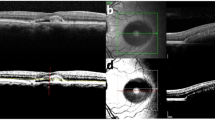Abstract
Purpose
The vitelliform stage is the typical phenotypic manifestation of Best vitelliform macular dystrophy (BVMD). As yet, no study has focused specifically on the clinical changes occurring in the vitelliform stage over the follow-up.
Methods
The survey takes the form of a prospective observational study with a 5-year follow-up. Twenty-one eyes of 11 patients in the vitelliform stage were examined annually. The primary outcome was the identification of the changes in the vitelliform lesion over a 5-year follow-up. Secondary outcomes included changes in structural optical coherence tomography (OCT) parameters and the correlation with the BCVA variation over the follow-up.
Results
Spectral domain OCT at baseline showed one subform characterized by solid vitelliform deposition, in 81% of eyes, and another subform characterized by a combination of solid deposition and subretinal fluid, in 19% of eyes. Overall, 62% of eyes showed an increase in the area of vitelliform deposition. Once the maximal area was reached, a progressive flattening of the vitelliform deposition took place, with subsequent flattening of the vitelliform lesion and formation of subretinal fluid. Hyperreflective foci (HF) increased in number as long as the vitelliform area continued to expand, with no variation in HF when the vitelliform lesion flattened or the subretinal fluid formed.
Conclusions
The vitelliform stage reveals more subforms with clinical variations over the follow-up. Our data suggest that the substage before the flattening of the lesion, thus before the so-called subretinal fluid accumulates and when the visual acuity is still high, might offer the best opportunity for an optimal therapeutic approach.

Similar content being viewed by others
References
Gass JDM (1997) Best’s disease. In: Gass J (ed) Stereoscopic atlas of macular diseases. Diagnosis and treatment. Vol 1, 4th edn. Mosby, St Louis, pp 304–311
Boon CJF, Klevering B, Leroy BP et al (2009) The spectrum of ocular phenotypes caused by mutations in the BEST1 gene. Progr Ret Eye Res 28:187–205
Booij JC, Boon CJF, van Schooneveld MJ et al (2010) Course of visual decline in relation to the Best1 genotype in vitelliform macular dystrophy. Ophthalmology 117:1415–1422
Battaglia Parodi M, Castellino N, Iacono P et al (2018) Microperimetry in Best vitelliform macular dystrophy. Retina 38:841–848
Battaglia Parodi M, Iacono P, Romano F, Bandello F (2018) Spectral domain optical coherence tomography features in different stages of Best vitelliform macular dystrophy. Retina 38:1041–1046
Battaglia Parodi MB, Iacono P, Campa C et al (2014) Fundus autofluorescence patterns in Best vitelliform macular dystrophy. Am J Ophthalmol 158:1086–1092
Battaglia Parodi M, Iacono P, Del Turco C et al (2015) Functional assessment of the fundus autofluorescence pattern in Best vitelliform macular dystrophy. Graefes Arch Clin Exp Ophthalmol 254:1297–1302
Battaglia Parodi M, Romano F, Sacconi R et al (2018) Intraretinal hyperreflective foci in Best vitelliform macular dystrophy. Retina 38:2379–2386
Murdoch IE, Morris SS, Cousens SN (1998) People and eyes: statistical approaches in ophthalmology. Br J Ophthalmol 82:971–973
Author information
Authors and Affiliations
Corresponding author
Ethics declarations
Conflict of interest
Francesco Bandello consultant for Allergan Inc. (Irvine, California, USA), Bayer Shering-Pharma (Berlin, Germany), Hoffmann-La-Roche (Basel, Switzerland), NTC Pharma, Novartis (Basel, Switzerland), SIFI, SOOFT, Thrombogenics (Heverlee, Belgium), and Zeiss (Dublin, USA). All other authors have no disclosures to declare.
Ethical approval
All procedures performed in studies involving human participants were in accordance with the ethical standards of the institutional and/or national research committee and with the 1964 Helsinki declaration and its later amendments or comparable ethical standards.
Informed consent
Informed consent was obtained from all individual participants included in the study.
Additional information
Publisher’s note
Springer Nature remains neutral with regard to jurisdictional claims in published maps and institutional affiliations.
Rights and permissions
About this article
Cite this article
Battaglia Parodi, M., Romano, F., Arrigo, A. et al. Natural course of the vitelliform stage in best vitelliform macular dystrophy: a five-year follow-up study. Graefes Arch Clin Exp Ophthalmol 258, 297–301 (2020). https://doi.org/10.1007/s00417-019-04454-4
Received:
Revised:
Accepted:
Published:
Issue Date:
DOI: https://doi.org/10.1007/s00417-019-04454-4




